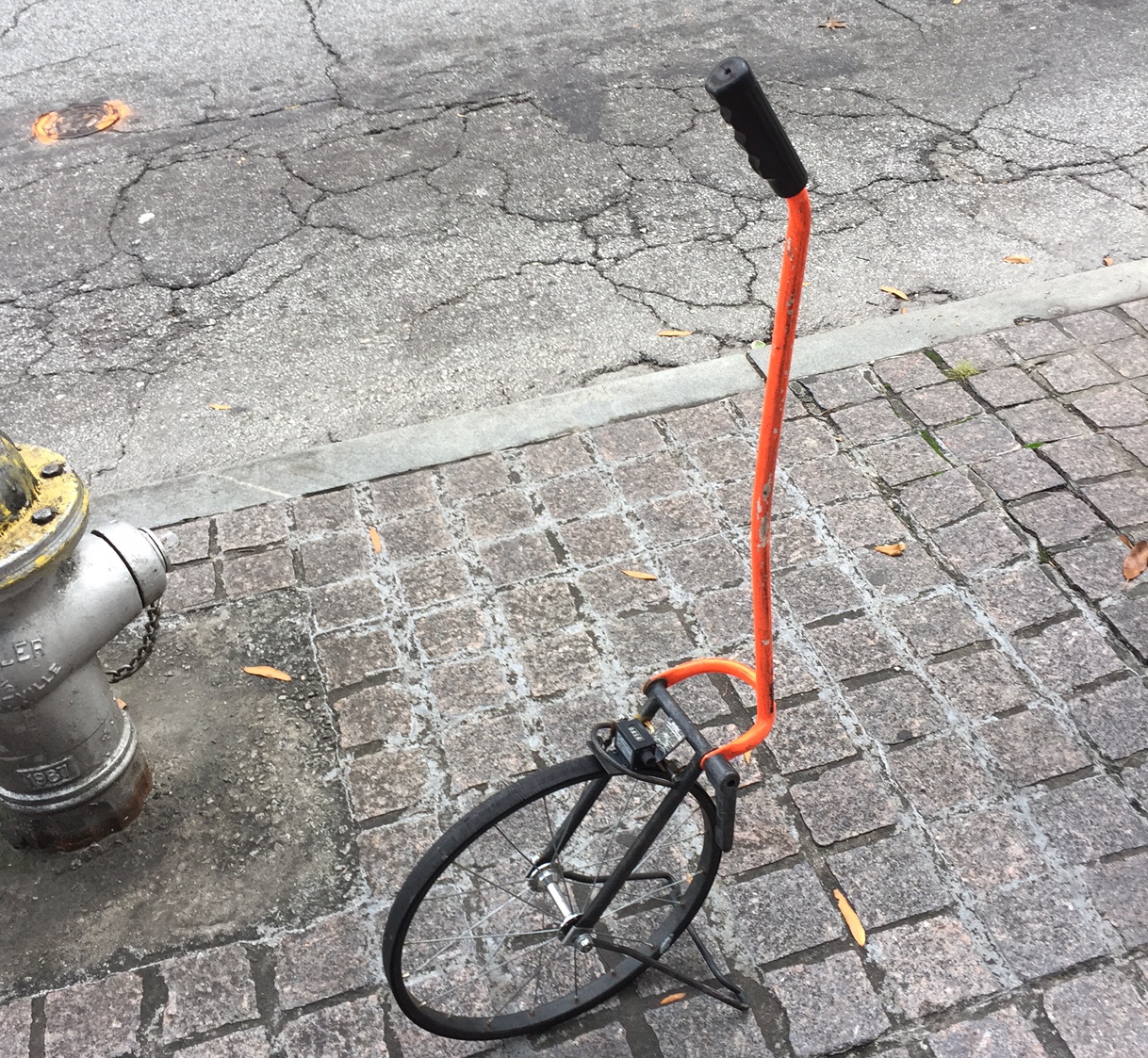Lesson 11
Building a Trundle Wheel
11.1: What Is a Trundle Wheel? (10 minutes)
Optional activity
In the previous lesson, students tried using simple methods and tools to measure long distances. In this activity, they learn that a trundle wheel is a tool used in real-world situations to measure such distances. From an image and a description of what a trundle wheel looks like, students think about how the tool works and how they could build one. Students think about the tasks for which a trundle wheel is an appropriate measuring tool (MP5). This builds on work students did in an earlier unit, when they learned about the relationship between the circumference of a wheel and the distance it travels.
Launch
Keep students in the same groups of 3–4 from the previous lesson. Explain to students that a trundle wheel is a measuring device composed of a handle, a wheel, and a device that clicks each time the wheel completes on rotation. Give students 5 minutes of quiet work time followed by whole-class discussion.
Design Principle(s): Support sense-making
Student Facing
A tool that surveyors use to measure distances is called a trundle wheel.
-
How does a trundle wheel measure distance?
-
Why is this method of measuring distances better than the methods we used in the previous lesson?
-
How could we construct a simple trundle wheel? What materials would we need?

Student Response
For access, consult one of our IM Certified Partners.
Anticipated Misconceptions
Students may not remember the relationship between the circumference of a wheel and the distance traveled by the wheel. Remind students of this idea from previous lessons.
Activity Synthesis
The goal of this discussion is for students to remember the connection between the circumference of a wheel and the distance the wheel travels during one rotation, so that they are prepared to use a trundle wheel to measure distances in the next activity. Invite students to share their ideas about how to build a trundle wheel and ask them how their design will allow them to measure distances.
Consider asking the following questions:
- “What information about the wheel do we need to know? What quantities should we measure?”
- “Why is it important to have a clicking device? What information does the device give us?”
- “If we have a wheel that has diameter 25 cm and we count 11 clicks to go across the classroom, what is the length of the room?” (Answer: \(25\pi\boldcdot 11\) or between 8 and 9 m.)
We can measure distance by counting the rotations of the wheel and multiplying by the circumference of the wheel. The construction of the trundle wheel allows us to easily count the rotations as we walk.
11.2: Building a Trundle Wheel (25 minutes)
Optional activity
In this activity, students build a trundle wheel and use it to measure distances in the classroom. The trundle wheels need to be stored in the classroom for use in the next lesson. If it is not feasible to store a trundle wheel from every group of 3–4 students, have them combine to form larger groups before building the wheels. Each student should still get a chance to practice measuring with the trundle wheel.
It is suggested that students build their trundle wheels using a paper plate as the wheel, two rulers taped together end to end as the handle, a metal paper fastener, and an index card taped to the wheel to produce an audible “click” when it hits the handle. There are many other ways to build a trundle wheel. If this fits into the culture of the class, students can use other designs and materials, e.g., students could use a bike with a playing card in the spokes to count rotations.
Launch
Keep students in the same groups, or if necessary, combine them to form larger groups. Discuss how to build the trundle wheel and distribute the supplies. Give students 15 minutes of group work time to build and try out their trundle wheels, followed by whole-class discussion.
Student Facing
Your teacher will give you some supplies. Construct a trundle wheel and use it to measure the length of the classroom. Record:
-
the diameter of your trundle wheel
-
the number of clicks across classroom
-
the length of the classroom (Be prepared to explain your reasoning.)
Student Response
For access, consult one of our IM Certified Partners.
Anticipated Misconceptions
Students may need some trial and error in building working trundle wheels, in particular for placing the clicking device. Encourage them to try out their design and then revise it as necessary.
Activity Synthesis
The goal of this discussion is for students to double-check that their trundle wheels work correctly and their results are reasonable. Invite one group that used each size of paper plate to demonstrate how their wheel works by walking across the classroom and counting the “clicks.” Record the data for all to see and discuss how these groups’ calculations for the length of the classroom compare, which may include the following points:
- The group with the smaller plate had a larger number of clicks and vice versa.
- Each group needs to multiply their number of clicks by the circumference of their wheel.
- The circumference of the wheel can be found by multiplying the diameter times \(\pi\) or the radius times \(2\pi\).
- Should we report our answer in terms of \(\pi\) or use an approximation?
- Are the groups’ answers for the length of the classroom pretty close or very different?
- Is it possible to count half rotations of the wheel?
Supports accessibility for: Conceptual processing; Memory
Design Principle(s): Maximize meta-awareness; Cultivate conversation